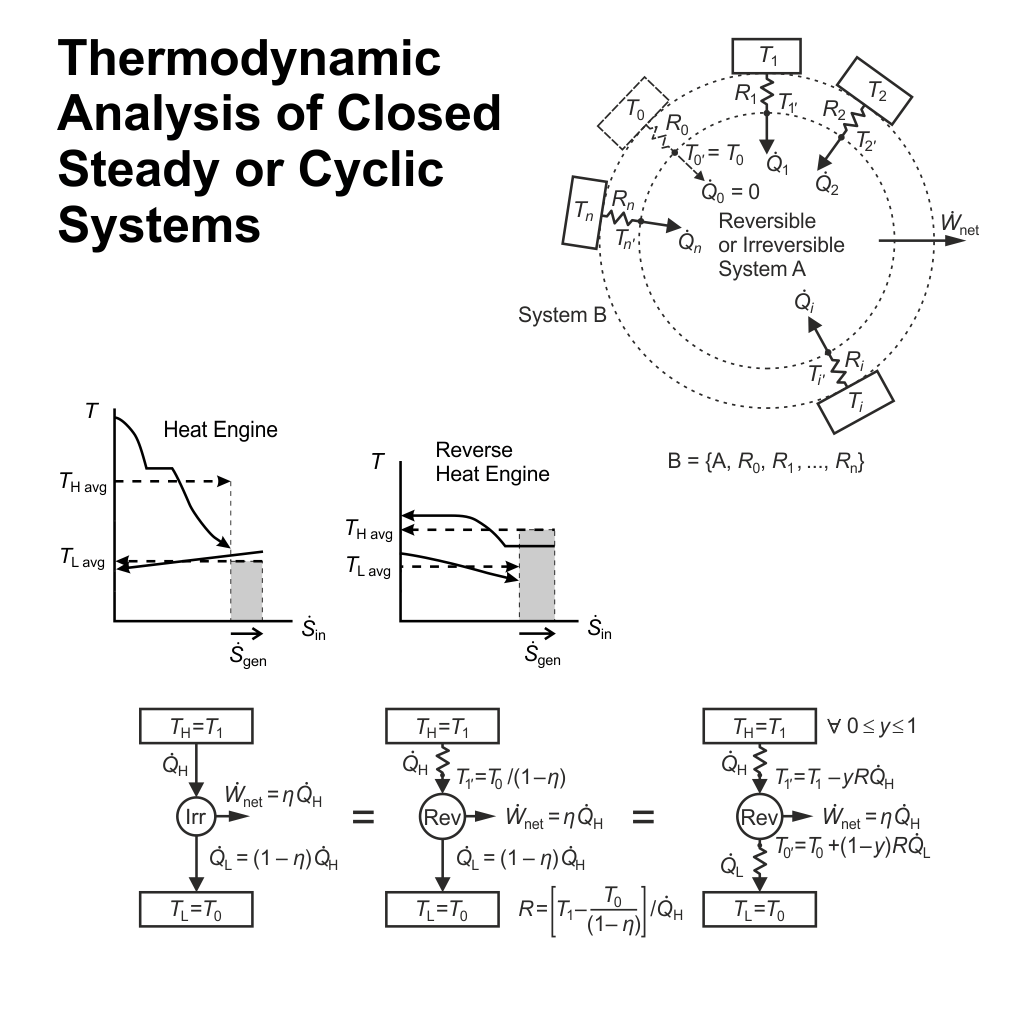On 29 September 2015 I published a paper in the journal Entropy about thermodynamic analysis of closed steady or cyclic systems. This resulted from my participation in the Joint European Thermodynamics Conference, which took place in May 2015 in Nancy, France. At the conference I delivered a presentation entitled ‘Available work rate of a reversible system bounded by constant thermal resistances linked to isothermal reservoirs’. The presentation was well received and I greatly enjoyed presenting it and responding to the questions that were asked. Over the summer of 2015 I completed the writing of the full paper and responded to points raised by the reviewers. I was able to focus intensely on it. I found the entire process very stimulating and was rewarded by a number of realizations that I had made progress. I felt that my insight into heat engines deepened considerably. I hope this paper is a small step forwards in thermodynamics and I hope it can be a unifying one. It’s not my paper, it’s ours, which Is why I wrote it in the first person plural, inclusive. I’m delighted that it is available as an open access article. I am grateful to the reviewers and the editors. Through them I felt empowered to be bold.
Research Impediments
It’s now almost four years since I took up my current post as a Senior Lecturer 1 at the Dublin Institute of Technology. I had been asked to give a presentation about ‘Providing academic leadership’ as part of the application process. The document I prepared for it has been on my web site ever since. It is still there, but today I removed the link from the homepage and I have reproduced it below.
The linked document is a personal expression in relation to academic leadership at a particular moment in time and under the rather specific heading of “Providing academic leadership through the role of Senior Lecturer 1 (Teaching) using the theme of ‘Sustainable Energy’ as an example.” (PDF file 74KB)
Proposed Project: Decoupled Stirling Engine
This project was submitted unsuccessfully for consideration for funding under the DIT Fiosraigh Research Excellence Award scheme. Perhaps I did not provide sufficient detail or maybe it was not clear what I was trying to achieve and, of course, I was up against very strong competition.
Continue reading
Particle Detectors or Shields
Yesterday I published a document in the ARROW@DIT archive with the title ‘A Suggested Building Block Geometry Without Continuous Radial Joints of Possible Relevance for Particle Detectors’. It is a hand-written document that I wrote while on holidays in Germany in 2009. It is available at this link https://arrow.dit.ie/engschmecart/16/.
Continue reading
Proposed Project: SEAWAVE
SEAWAVE stands for Simulation Engineering Applied to Wave Analysis, Validation and Estimation. I put forward this proposal in 2009 under the Enterprise Ireland Commercialisation Fund Proof of Concept scheme. It did not proceed, partly because there was a view in my own institute that the idea was not sufficiently developed and that adequate groundwork in seeking commercial backers had not been done.
Continue reading
Proposed Project: Geometrical Analysis of a Ball Camera
The concept to be analysed is a proposed camera that would operate somewhat like the human eye. Rather than capturing an image on a rectangular flat surface, as is common in current cameras, the image would be captured on the inside surface of a sphere or spheroid.
Continue reading
Proposed Project: Generic Discrete Simulation of Thermo-mechanical Components and Systems
This project will develop new methods of characterising and simulating components, machines, plant or systems that involve heat transfer, mechanical operations, energy conversion, cycles or flow processes (i.e. thermo-mechanical components, systems or machines) through discrete characterisation, topological network models, lumped elements and the characterisation of interaction interfaces.
In effect, what is proposed is the engineering equivalent of object oriented programming. Generic models will be developed for common, or uncommon, components, systems and assemblies that capture the essence of those things in the simplest and most compact form and also define how the represented item can interact with generic models of other items that might be introduced to it, brought into contact with it or connected to it.
Continue reading
Proposed Project: Symmetry Engineering
Symmetry in engineering, science and mathematics—a study of the fundamentals with a view to developing new cross-disciplinary methodologies and applications—MPhil or PhD project by research
It is well recognized that symmetry underlies the processes and laws of nature. Developing an understanding of symmetry has already helped engineers, scientists and mathematicians to make significant advances in their respective fields. This research project will be characterized by the fact that the study will be undertaken within a Department of Mechanical Engineering and making use of some of the approaches, tools and techniques that are used by engineers, but yet also reaching out to other disciplines.
Continue reading
My Conclusions from the Phoenix Energy Sustainability Conference
A summary of what I have learned is that solar energy engineering is in a phase of rapid development. It is profitable business and there is still quite a way to go before plateau performance levels will be reached. Real progress is being made in reducing the costs of photovoltaic collectors. Issues of inverting and cleaning up the power produced and integrating it with the grid appear to me to have been largely solved. Reliability and durability of photovoltaic panels seem to be very satisfactory. Costs of these units appear to be decreasing quite rapidly. Efficiency values are still increasing, but are already at levels that I consider very good. Furthermore, concepts such as combining photovoltaic collection and thermal collection or using concentration with photovoltaic collectors are subjects of current research.
Continue reading
My Experience of the ASME Energy Sustainability Conference 2010
The ASME Energy Sustainability conference was a co-located conference with the annual National Solar Conference of the American Solar Energy Society. I found it an excellent conference, although for me it was rather impersonal.
Continue reading
